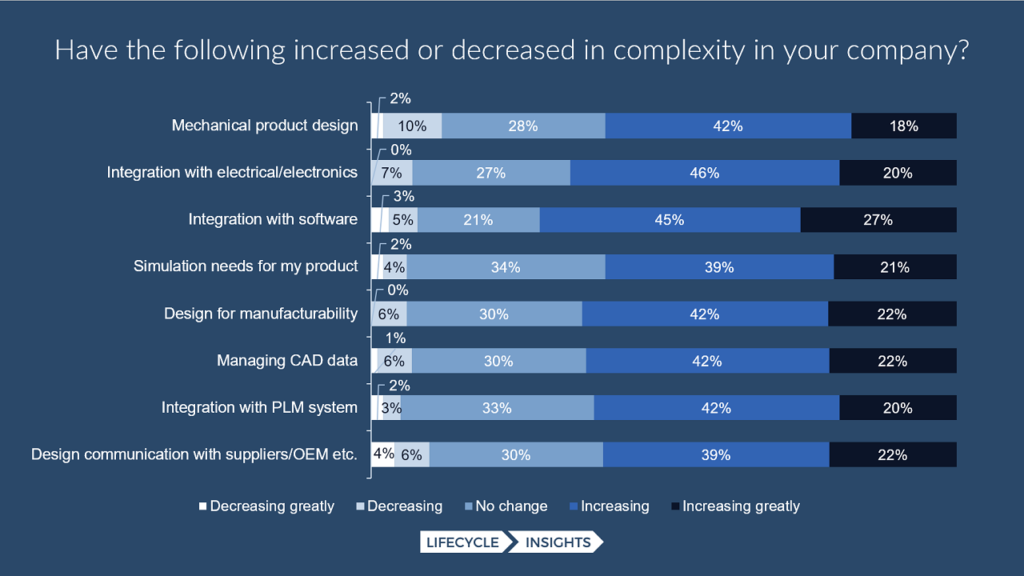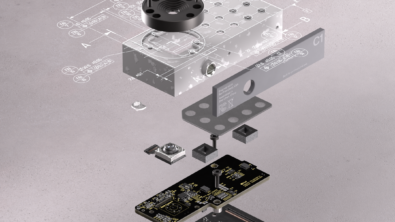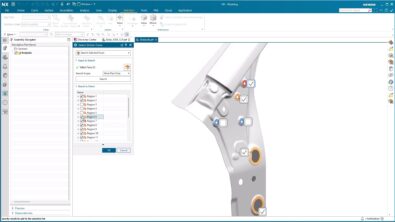Large Manufacturing Organizations Increase Productivity with CAD and PLM Solutions

The verdict is in: Executives are looking for new ways to boost productivity in their mechanical design teams. Findings from Lifecycle Insights’ 2021 Computer-Aided Design (CAD) Productivity Study indicate that this is true for organizations of all sizes.
While both large and small organizations are looking to CAD solutions to help improve productivity, there are key differences in the obstacles they must overcome. The challenges faced by large organizations are different from the ones many of their smaller counterparts must mitigate.
Mechanical Design Productivity in Large Organizations
Given today’s demands in the manufacturing market, finding ways to increase productivity is crucial for both small and large organizations. To better understand how new releases of CAD solutions might impact engineering productivity, Lifecycle Insights conducted the 2021 CAD Productivity study. More than 94% of respondents stated company executives wanted some degree of productivity improvements from their mechanical design teams.
There are many reasons for this, and they vary across organizations of different sizes. Larger organizations must develop more complex systems, interface with a larger number of suppliers, collaborate with more stakeholders across the product design process, and integrate their development processes with a host of IT systems. This post will discuss the challenges involved in coordinating with a large number of design participants. It will also examine the importance of CAD integration with product lifecycle management (PLM) to achieve much-needed productivity gains.
Suppliers Influencing Design
It’s no surprise that the needs of large organizations are different from those of smaller companies. There are many reasons for this. But one that stands out is the role that suppliers often play in product design with larger manufacturers.
Larger organizations are more likely to build complex products containing many systems that must come together so the product can function as a whole. This means that key suppliers participate in the design and supply of constituent systems.
For example, if you consider the original equipment manufacturer (OEM) for an automobile, it is easy to see how working with several different suppliers influences product design. Today’s automobiles are constructed from a variety of different mechanical, electrical, and electronics systems that are often supplied by other manufacturers. Across industries, larger organizations often rely on multiple suppliers. They must find ways to effectively collaborate with all of them in order to release new products on time.
To do so, larger organizations leverage several IT solutions, including PLM platforms. PLM solutions facilitate better communication between engineers and stakeholders both in and outside of the organization during the design process. To effectively work on these more complex designs, it’s essential that all stakeholders have the latest design information at their fingertips, as well as access to all associated communications. That means having an easy way to share CAD data and communications.
When organizations tightly integrate their CAD solution with the PLM system, they can better ensure that all stakeholders have access to the latest design information, including any changes. While this type of integration is important for organizations of all sizes, it is indispensable for larger manufacturers. Without it, they will struggle to manage design information and communications between the design team and multiple suppliers.
Increasing Complexity in Design Communication with Suppliers
The need to communicate with a large number of suppliers to enable efficient product development is only one challenge that larger organizations face. Lifecycle Insights’ 2021 CAD Productivity study also found that large organizations face increasing complexity when it comes to communicating and collaborating with suppliers on their designs.
Overall, 39% of survey respondents stated that design communications with suppliers and OEMs have increased, and 22% said it has increased greatly. But when the survey separated out large organizations with revenue greater than $2 billion, those numbers rose. Some 44% of large organizations noted the increase in design communications with suppliers and OEMs, and 28% stated they have increased greatly. In comparison, smaller companies with revenues below $100 million, had corresponding responses at 39% and 10%, respectively.

These data points illustrate that organizations are battling increasing complexity when it comes to design communications with suppliers and OEMs. This challenge is magnified for large organizations, as suppliers play a critical role not just in manufacturing but also in designing new products. From the productivity impact perspective, large organizations see significant gains when their design team can easily and effectively communicate with all suppliers and stakeholders. This, clearly, is an area where PLM solutions add significant value. That’s why it’s little surprise that so many large organizations do, indeed, rely on PLM solutions to handle all product level exchanges with their suppliers and other external stakeholders during the design phase of product development and beyond.
CAD Integration with PLM Impacting Productivity in Large Organizations
Executives in large manufacturing organizations care deeply about finding ways to boost productivity in their design teams. They see that streamlining design communications with suppliers, in turn, improves productivity. Integrating CAD with their PLM solution is a great way to achieve better design communication.
The CAD Productivity Study findings demonstrate that this type of integration offers significant productivity benefits. For large organizations, nearly 66% of respondents felt that CAD integration with PLM had a “high” to “very high” impact on productivity. Some 17% noted that the impact of such integration offered medium benefits.
Why might CAD integration with PLM make such a significant impact on design team productivity? There are several reasons. To start, large organizations collaborate with multiple suppliers from the very first days of the design phase. Engineers from supplier organizations work closely with the engineers from the OEM to design the constituent systems that go into the product. They share CAD data and communicate at every stage of the design process. Integrating CAD with the PLM aids in these endeavors.
A design change in any one system in the product likely impacts the other systems as well as the functionality of the entire product. Therefore, it is critical that everyone is in the loop. All stakeholders must have easy access to the latest designs and an awareness of any changes that were made. CAD integration facilitates this sort of design environment.
Finally, while many stakeholders may be involved with a product’s design, not all of them will have access to the CAD solution. But they will still need access to specific CAD data to complete their tasks. For example, marketing will need the CAD model to develop websites and brochures. Procurement needs the bill of materials (BOM), derived from CAD data, for sourcing components. When larger organizations integrate CAD with the PLM solution, all these different stakeholders enjoy access to the latest data.
Conclusion
Manufacturing organizations, regardless of their size, are interested in facilitating productivity gains in their mechanical design teams. Yet, larger organizations face different challenges as they work on more complex designs with a larger number of supplier stakeholders. Lifecycle Insights’ 2021 CAD Productivity Study findings show that larger organizations see a significant boost in productivity when they integrate their CAD solutions with their PLM platform. Such integration facilitates easy access to CAD data and improved communications for engineers both in the organization and outside of it.
Read the full Lifecycle Insights CAD productivity research report
Comments
Leave a Reply
You must be logged in to post a comment.



Thanks for the useful tips. Really appreciate your work. https://1depositca.com/
CAD Productivity study also found that large organizations face increasing complexity when it comes to communicating and collaborating with suppliers on their designs. Area Code